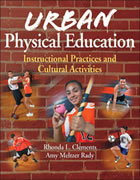EDITORIAL
Should
we be Concerned about Increased Public Support
for Physical Education’s Mission?
 In
case you missed it, there was what appears
good news for school physical education and
its mission this fall. Here’s a sampling: In
case you missed it, there was what appears
good news for school physical education and
its mission this fall. Here’s a sampling:
According to a CDC report, the worrying perceptions
many of us have had of ongoing program and
position cuts and declining support for K-12
physical education were wrong. In the recently
released 2012
School Health Policies and Practices Study
(SHPPS), a 10% increase was reported in the
percentage of school districts requiring elementary
school physical education over the past 12
years.
At the middle school level there was almost
a doubling of the percentage of states providing
lesson plans and tools for evaluating students’
progress. And nationwide there was a 20% increase
in districts adopting policies requiring schools
to follow national, state, or district PE
standards.
In Madison Wisconsin a Republican legislator
has authored a bill proposing to increase
PE requirements for students in grades
K-8. Concerned about the three billion-dollar
annual healthcare costs related to obesity,
this bill would add 30 to 45 minutes of daily
physical activity for students in K-8 not
enrolled in a "gym" class. Similarly
focused on countering worsening obesity, Healthy
U an anti-obesity initiative funded by
insurance giant Blue Cross Blue Shield but
implemented through the YMCA is expanding
into New Jersey schools.
In welcoming leaders from the National Foundation
for Governors Fitness Councils (NFGFC) to
a ribbon-cutting ceremony at state-of-the-art
school fitness centers, Delaware Governor
Jack Markell, wrote
that "healthy children learn better
and have a greater chance to reach their potential."
Governor Markell would undoubtedly be pleased
at the increasing amount of evidence tying
children's health to academic performance.
According to PBS, a recent study from the
University of Illinois found
that "fitter kids learn more effectively,"
findings similarly supported by a study
of nearly 12,000 schoolchildren in Nebraska.
And if all this news wasn't exciting enough,
it was also announced that a Brooklyn New
York charter high school is making physical
activity and sports the cornerstone
of its curriculum. Students start the
school day with three hours in teams and with
assigned "coaches." Founder and
Principal Jai Nanda explained that, "we
need to recognize that a full education requires
the kids are active." Presumably, similar
thoughts were on the minds of school district
officials in Milwaukee Wisconsin who planned
to reintroduce
physical education, arts, and music to
its schools after the prior budget cuts eliminated
them.
While these and similar stories are encouraging,
there’s an underlying worrying theme.
It concerns the muddled
relationship between physical education
and physical activity. Several years ago NASPE
attempted to distinguish key differences.
Today, to more and more people it appears
these differences are irrelevant. Of concern
is the growing tendency for funding entities
and decision-makers to focus mostly on doing
physical activity to children. In Wisconsin,
Delaware, and even the Brooklyn charter school
there's little mention of educating
students with the skills and knowledge
to lead healthy lifestyles, but rather the
simplistic pursuit of getting them physically
active. In other words, never mind teaching
them how to fish, let’s just
feed them daily!
Almost a century ago, in discussing the types
of physical activities that should be taught
in schools, physical educator Clarke
Hetherington distinguished between drill-type
activities (read into this calisthenics and
conditioning activities) and play. He ruefully
observed that children don't spontaneously
run to the playground in their free time to
pursue drills. Fast-forward to today and Hetherington's
point is worth reflection. Unfortunately,
well-meaning, obesity-solving adult physical
activity advocates don't seem to understand
what it takes to motivate children
to be physically active. It would help if
they took a step back and thought about their
own childhood.
None of us as children chose to be physically
active or play games and sports because we
were worried about our health or wanted to
improve our math and reading scores. It’s
simple. Watch a baby! Children start out physically
active not for ulterior motives but simply
for the joy that play and movement brings
to their lives. Sadly, the environment in
which we live today (for which adults are
largely responsible), conditions youngsters
to be sedentary.
People who want to get today's children to
be more physically active and enjoy the many
benefits, are headed in the wrong direction
if they think the answer is exercise programs
and fitness centers. Sure this may work for
some but not the vast majority of youngsters.
To motivate our students to be physically
active we have to introduce them to activities
that bring them joy. That make them
smile. That give them confidence in themselves.
That motivate them to want to be active rather
than be sedentary. In doing this we need to
consider individual differences. And this
is where physical education comes in.
In quality physical education programs students
are introduced to a wide variety of movement
experiences including different physical activities,
dance, and sports by professionally trained
teachers. Physically educating students
is vastly different from simply providing
physical activity. If we wanted to create
a world in which all children appreciated
music would we introduce them to only one
musical genre or instrument? Of course not!
And it makes just as little sense to force
children into narrowly prescribed primarily
fitness focused physical activity programs.
But as we see that's what's happening. Whose
fault is it? It's easy to blame others but
maybe all of us who teach physical education
are guilty of not doing enough to differentiate
between physical activity and physical education?
From a professional perspective this is worrisome.
Schools are now more willing to contract with
organizations such as the YMCA and private
companies to organize physical activity in
schools. How long before schools recognize
the potential huge financial savings of outside
contracting? What then for the physical education
teaching profession? In respect to news of
increased public support for getting kids
more active, those of us in the physical education
profession should probably be careful about
what we wish for.
Steve
Jefferies, publisher pelinks4u
|
















 In
case you missed it, there was what appears
good news for school physical education and
its mission this fall. Here’s a sampling:
In
case you missed it, there was what appears
good news for school physical education and
its mission this fall. Here’s a sampling: